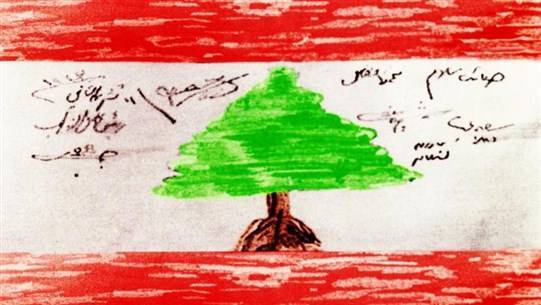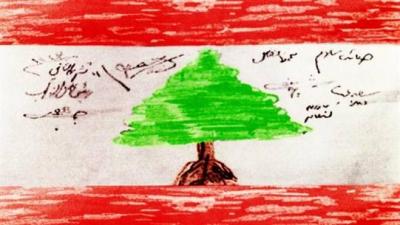Twenty-one days have passed in Lebanon with a vacant presidency, and the count continues to rise while tomorrow marks the 79th Independence Day without the usual celebrations. The political system remains unable to develop mechanisms for democracy to the extent that we can say it has squandered the trust given to it by great figures back in 1943. For instance, who remembers the creator of the Lebanese flag that flies everywhere in the country, on the flagpoles of the presidential palace, the parliament, the government palace, ministries, embassies, consulates, and all Lebanese diplomatic missions abroad? Who remembers the creator of the Lebanese flag, Saadi Almalla, from Tripoli, especially at a time when a political party that did not have a member in parliament prior to 1960 attempted to attribute this honor to itself in its political writings from a bygone era?
Let’s go back to November 1943, when the first independence president of the parliament, Sabri Hamada, called for an urgent session after French occupying forces arrested President Bishara Khoury, Prime Minister Riad Al-Solh, several ministers, and MP Abdul Hamid Karami. The invitations were carried to the parliament by its ushers and some officials, as the gendarmerie at that time complied with colonial orders and went around the homes of the deputies to notify them. Meanwhile, crowds gathered in the parliament square and surrounding streets, chanting in support of those detained in Rashaya Castle. (We want Bishara - We want Riad).
The speaker of the parliament and the few deputies inside looked out from the president's office windows at the furious crowd, greeting them and chanting back, but they requested that he not attempt to climb out to join them, so the crowd dispersed, complying with their representatives’ wishes. At that moment, Senegalese soldiers from the French army began surrounding the parliament, preventing anyone from entering. A large number of them initially gathered outside the main door, placing a soldier under each window to halt communications between the demonstrators and the deputies. Saadi Almalla approached the main door, but the Senegalese soldiers prevented him. The public signaled him to enter through the window directly to the president's office. When the deputies inside saw their colleague near the window preparing to climb it, they gestured to the crowd to carry him on their shoulders. The crowd surged forward, lifted the deputy, and he was thrown against the window's iron frame, clinging to it with both hands, half of his body inside the office and half outside.
At that moment, the soldier assigned to guard the window charged at the deputy, aiming his rifle at him, but a young athletic man named Hussein Sajjan leaped forward and seized the soldier's neck, keeping the deputy safe while the deputies inside pulled their colleague back. This window has since been known as “Saadi Bey’s Window.”
This incident prompted the French to increase security around the parliament. The Senegalese soldiers tightly surrounded it, preventing anyone from entering. The deputies who had received the president's call found themselves obstructed by soldiers from entering the parliament. They then retreated and headed to the house of the detained president and prime minister in Rashaya Castle. Notably, one soldier attempted to prevent MP Rachid Baydoun from entering the parliament, but he managed to enter forcibly after pushing the soldier away and gathering public support.
The number of deputies who actually entered the parliament building was reduced to seven: President Sabri Hamada, Saib Salam, Henry Faraon, Rachid Baydoun, Maroun Kan'an, Mohammad Fadl, and Saadi Almalla. When President Sabri Hamada lost all hope of contacting the outside world, he called the remaining six deputies to gather in the main session hall, where they began drafting a strongly worded memo. President Hamada noted in this regard: “It was not easy to break the siege imposed on us by the French and establish contact with embassies to inform them of developments and the resolutions of the parliament while we remained resolute against the French. An agreement was reached with Albert Faraon, Henry Faraon’s uncle, that the president would send him the text of the resolutions and protest telegrams hidden inside one of his aides’ shoes.”
The memorandum stated: “The undersigned deputies, able to reach the parliament, express that they speak on behalf of the entire council, which unanimously elected His Excellency President Bishara Khoury as the constitutional leader of the Lebanese Republic, which unanimously granted Prime Minister Riad Al-Solh’s government its trust, and unanimously amended the Lebanese constitution in line with the dignity of the nation.” The deputies noted their condemnation of the brutal assault and reprehensible actions taken by armed French soldiers on the night of November 10-11 against His Excellency Sheikh Bishara Khoury, the President, and His Excellency Riad Al-Solh, the Prime Minister, and the legal ministers.
The deputies signed the memorandum: President Sabri Hamada, Saadi Almalla, Henry Faraon, Saib Salam, Rachid Baydoun, Mohammad Fadl, and Maroun Kan'an. President Hamada added, "Once we finished drafting the historical resolutions, we climbed up to the parliament's roof overlooking Albert Faraon’s office, who understood the signal, quickly took the papers from my aide, and delivered them to those I had sent them to. We then began replacing the flag, which featured the cedar tree amid French colors, with a pure Lebanese flag."
In this regard, President Saib Salam, in a meeting with me, mentioned: “After we removed all colonial and mandate provisions from the constitution in a previous session, the Lebanese flag remained as the Muslims wanted an Arab flag consisting of the colors white, red, green, and black. In contrast, Christians desired a French flag, but instead of being vertical, it would be horizontal with a cedar in the middle. Amid this chaos, we sought to resolve this disagreement. Henry and I came up with the idea of the flag: white symbolizes peace, red signifies blood and sacrifice for freedom and independence, and the green cedar in the center.”
The proposal to amend Article 5 of the constitution was formulated, pencils were brought, one black and one red. Saadi Almalla took on the task of drawing the new flag. Since a green pencil was not available, the cedar was drawn with a regular black pencil. After that, they all signed the drawings and the proposal. The president and the deputies swore that these colors would become the flag of future Lebanon and that they would present it to the nation once conditions permitted for it to be adopted in the first session held by the parliament. Emotions ran high as the deputies congratulated one another.
This historic session continued until 2 PM when the Senegalese soldiers stormed the parliament after the French authorities had had enough of the deputies' presence inside and realized that their existence symbolized what needed to be in an independent country that protects the sanctity of the constitution. They decided to evacuate the parliament after a six-hour siege, and the sound of the Senegalese soldiers' footsteps echoed in the empty halls. Each took their place as the president settled into his chair. The deputies recalled Mirabeau’s famous words to the king's messenger: “Go tell your master that we are here by the power of the people and we will not leave except on the tips of our bayonets.”
About twenty soldiers entered the room, led by an officer brandishing a pistol. The president and the members remained still. When they reached the center of the hall, the president addressed the officer, saying, “Who authorized you to enter and confront the President of the Lebanese Parliament and the representatives of the people under the parliamentary dome?”
The French officer replied, “Mr. President, I have orders to evacuate the parliament, and I ask for your assistance in carrying them out.” The president responded, “We do not comply with anyone’s orders; we are in an independent country, and you have no business with us. Go back from where you came.” The officer repeated, “Mr. President, I am a soldier, and I must obey orders. I have delivered them to you.”
The president replied, “We are here and will not leave this hall of our own free will, so do what you must.” The officer said, “Then you will leave by force." He signaled to the soldiers, forcing the president, deputies, and employees to exit.
As the crowds gathered around the parliament from the morning, they saw the president and the deputies and marched behind them in a boisterous demonstration, chanting in support of the deputies as the procession made its way through the streets of Beirut towards President Bishara Khoury’s house. The cheers reached the skies, while women appeared at their balconies, showering the president and the six deputies with flowers and applauding them profusely.
Notably, President Saadi Almalla headed the first independent government from May 22, 1946, to December 14, 1946. During his tenure, the first labor law in Lebanon was enacted, following his tenure as Minister of Justice in Sami Al-Solh's government from August 12, 1945, to April 11, 1946, and Minister of Interior from April 11, 1946, to May 18, 1946.




